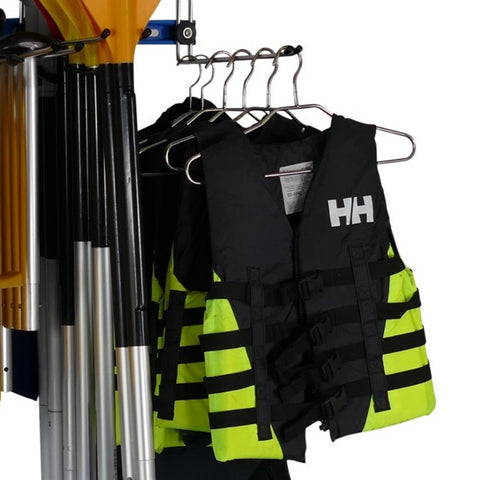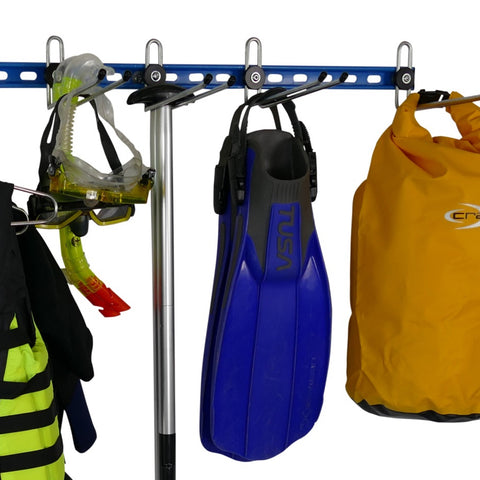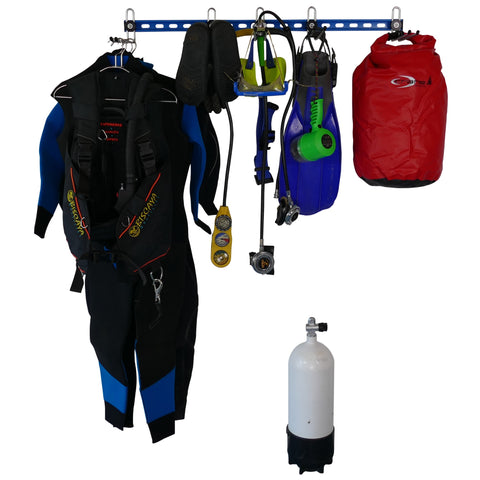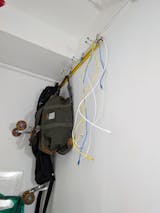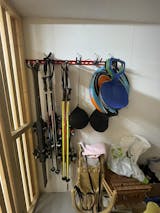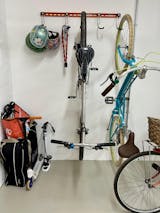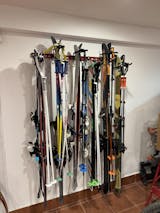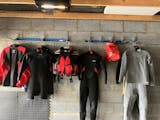
What is the best way to store a lot of water sports gear?
Share
The best way to store water sports gear, whether it’s inside or outside, is on a wall mounted rack or a free standing clothes rail. This means everything can drip dry and there is room for air to circulate and keep it dry. If clothing is folded and stored in boxes, where air cannot circulate, it will rust or go fusty, grow black fungus, start to smell and may be permanently stained or damaged.

Water sports clothing and equipment can be a problem to store. Clothing is likely to be wet or at least damp and lots of water sports equipment is big and bulky. Hanging it all on a wall mounting rack or a free standing clothes rail is a good short or long term storage option.
Before storing water sports clothing or equipment it should be rinsed with clean cold water, especially if it has been used in the sea. You should also give it proper clean with warm soapy water once in a while to keep it fresh. It’s important to get any water sports gear bone dry before hanging it up. Be careful about leaving wetsuits or kayaks in the sun for too long as they will degrade over time.
What is the best way to store a wetsuit?

The best way to store wetsuits is on hangers so they can drip dry and so air can circulate to keep them dry. Turning them inside out will help them dry quicker. Avoid folding the wetsuit as neoprene will eventually crack. Do not keep wetsuits in a sealed plastic box or a bag because any trace of moisture left in the material will encourage mould to grow and metal parts to rust.
Before you even think about storing your wetsuit you need to get it clean and free from any salt water. Start by rising your wetsuit in cold, clean water. Every now and again you should wash it, by hand, in some luke warm water and a little soap.
Wetsuits are really heavy when wet so you are going to need some heavy duty clothes hangers to hang each suit up while it dries. You can buy special wet suit hangers if you like but any heavy duty plastic or stainless steel hanger will do. Avoid wooden or ordinary steel hangers as these will get damp or rust.
Once dry, its best to leave a wetsuit on a hanger so air can continue to circulate and keep it dry and fresh. The main thing is not to fold it up and put it in a drawer or box. Any residual damp (and there will be some - probably quite a lot) will make it fusty, mouldy and smelly in no time. Neoprene will also be permanently marked and creased by folding and may actually rupture and tear along fold lines.
Should I hang or fold my wetsuit?
It is generally recommended to hang a wetsuit it rather than fold it. Folding a wetsuit can create permanent creases or folds in the neoprene material, which may weaken its structure over time and affect its insulation properties. By hanging the wetsuit, you can help maintain its shape and integrity and allow it to dy properly.
To properly hang a wetsuit, use a wide and padded hanger designed specifically for wetsuits or a suit hanger with rounded edges to prevent shoulder deformation. It's also important to turn the wetsuit inside out before hanging it. This allows the inside of the wetsuit to dry completely and reduces the risk of mold or mildew growth.
Choose a cool, shaded area to hang the wetsuit away from direct sunlight, as prolonged exposure to sunlight can degrade the neoprene material. When hanging the wetsuit, avoid hanging it solely by the shoulders, as this can stretch out the material. Instead, use a hanger that supports the entire width of the shoulders to distribute the weight evenly.
How do you store life jackets and buoyancy aids?
Life jackets and buoyancy aids, that are used for recreational water sports, are big and bulky so quite awkward to store. They should be rinsed with cold water and washed after use. They will need hanging up to dry and are best stored hanging rather than been stuffed in a box which will allow mildew to form.
Life jackets and buoyancy aids only used in emergencies on a boat should be stored on-board the vessel where they can be accessed easily. Exactly where will be dictated by the design of the vessel and signs should inform people where these are. They should be stored be out of direct sunlight to avoid degradation and should be checked regularly.
Can life jackets be stored outside?
Life jackets and buoyancy aids can be stored outside for a short period while they dry. For longer term storage outside they should be kept out of direct sunlight which can degrade plastic parts and cause them to become brittle and crack.
How do I keep my life jacket from smelling?
You can stop life jackets and buoyancy aids from smelling by making sure they are perfectly dry when they are stored. Hanging them up on hangers will allow air to circulate and keep them dry. Avoid storing in sealed bags or boxes and this will trap moisture and cause mildew and will make them smell.
What is the best way to store a lot of water sports gear at home

Once they are dry, the best way to store wetsuits and buoyancy aids is on hangers, but where do you put them?
Wetsuits are bulky and long so hanging in a wardrobe is not really an option. Several wetsuits, even when dry, can still weigh a lot and can bend or break normal hanging rails. If you have a laundry or boiler room that would be OK but if you have a few wetsuits you risk damaging pipe work and you will soon run out of space.
How to store water sports gear in a garage or shed

If you have a dry garage or shed then a compact, wall mounted storage rack is going to be ideal. This will minimise space and make everything easy to get to and put away again. Hanging things like wet suits and buoyancy aids will allow them to dry out properly and keep them dry.
Somewhere dry is the most important thing and if it is in a warm environment, even better. For most people this is going to be in a shed or garage but be warned: if these are cold and damp for long periods of time things will eventually rust, rot and smell.
Alternatively, if you have space in a large boiler room, tack room, cloakroom or even a spare alcove in a house or flat, then a wall mounted storage rack is going to be ideal.
Wall mounted water sports storage rack
Our Water Sports Wall Storage Rack has 1 meter long rail that can be fitted, with just 3 holes, to a wooden or solid wall. To this can be fitted 3 or more hooks that are specially designed for water sports gear. The rail is galvanised AND powder coated and the hooks are all bright zinc plated so nothing will rust even if its installed outside.
The water sports hooks are 300mm long which means that each hook can accommodate a lot of gear like up to 8 wetsuits, 6 buoyancy aids, 6 helmets as well as loads of paddles and other smaller gear like masks, fins and snorkels.
Any hook can be fitted anywhere on the rail so you can easily move hooks around to create space on the rail. You can also add or remove rails, all with just an Allen key which we provide.
What’s the best way to store a blow up paddle board, canoe or dinghy

If you are storing inflatable dinghies, canoes or paddleboards at the end of the season it is vital to get all parts, such as the inner bladders, shell and even the bags, properly dry before you put them away. If the inflatable has an inner bladder and an outer nylon shell it is best to separate and dry them independently. Even the outer bag needs to be bone dry, otherwise black mould will grow which will permanently stain everything.
The hooks on the GearHooks rack are heavy duty so you can hang heavy things like a blow up kayak, canoe or paddleboard on the rack in its pack-away bag. Heavy things should be hung closest to the wall but if you have long straps on the bag, or if each item is around 10 kilos, then you can hang a couple of inflatables on the same hook.
How to store rigid canoes and Kayaks
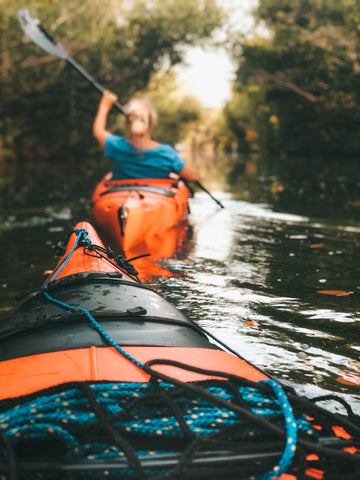
Rigid water craft tends to be big and difficult to store. If it is left outside it is vital to protect them from the sun. Water sports gear like kayaks or anything made from fibreglass or plastic should be kept out of the sun as much as possible as they will fade and become brittle if subjected to ultra violet light for long periods.
If you have a garage with space in the roof then storing them up there is a good solution. However, it can be difficult to mount them in the ceiling, hard work to get them up there and you can easily hurt your back putting them up or getting them down.
Other solutions include floor standing racks which will hold 2 or 3 kayaks but these take up a lot of floor space, especially if they are double sided. Mounting them on the wall is often a better solution to get things off the floor and out of the way. There are a variety of ways to hold them against the wall including long brackets and fabric straps.
What is the best way to store paddles?
Paddles for canoes, kayaks and dinghies are a pain to store. If propped in a corner they are bound to fall over and cause mayhem. One way is to drop them into a dustbin or something similar but that isn’t ideal as they can still fall over, like a wilting vase of flowers, and the blades will fill the bottom of the bin really quickly.
A wall mounted rack that has long hooks with a 25mm to 50mm gap is the ideal way to hold up to 12 paddles one behind the other. It keeps them all together, neatly racked up one behind the other so they are easy to get to and will not fall over.
How to store diving gear
Diving gear includes bulky and heavy items like scuba tanks and diving weights as well as awkward items like regulators and smaller bits and pieces.
The safest pace for scuba tanks is on the floor but nothing else should be left on the floor. Mice and other rodents will chew through neoprene wet suits and they love the stuffing in buoyancy aids. Anything left on the floor will not dry out properly not to mention getting kicked all over the pace.
Wetsuits and dry suits should be hung up to dry and not folded for long term storage. Ideally, these should be stored on hangers so they can dry properly and are not permanently creased by folding. Buoyancy aids should also be stored on hangers, rather than in boxes, so they stay aired and fresh.
The GearHooks Diving Rack has all the hooks you need for your diving equipment.
How to store facemasks, snorkels, swim fins (or flippers) and all the other water sports gear
Smaller bits and pieces like facemasks, snorkels, fins, dive computers, flashlights etc. are often stored in boxes. Anyone who has done this will know that any moisture can become trapped and things soon rust or go fusty.
An alternative is to hang them up where they can be found easily without rooting about in the bottom of a box. They will also stay drier and will look pretty cool all hanging in neat rows. Our heavy duty hooks will even hold diving weights, up to 20Kg per hook.
Can you store all your water sports gear in one place?
Yes, as long as you have a decent rack of some kind. The GearHooks Water Sports rack is designed to hold everything on a wall mounted rack with plenty of long hooks. It will take a variety of gear like wetsuits and dry suits (around 8 per hook), buoyancy aids/life jackets (around 6 per hook), helmets (6 per hook), regulators, flippers, masks and lots, lots more.
It’s all really heavy duty too so hanging so hanging up inflatable paddleboards, canoes, kayaks, dinghies and all the associated paddles (up to 10 per hook) is easy. They will even take heavy diving weights.
Hanging all your water sports gear on the wall means it;
- is off the floor and saves space
- is safe from damage and vermin
- will dry out and stay dry
- is quick and easy to put away
- makes everything is easy to find
- looks great too!!
For more information about the GearHooks Water Sports Rack take a look at it on our website by clicking this link. If you need any more information or help just get in touch by email to luis@gearhooks.com.

